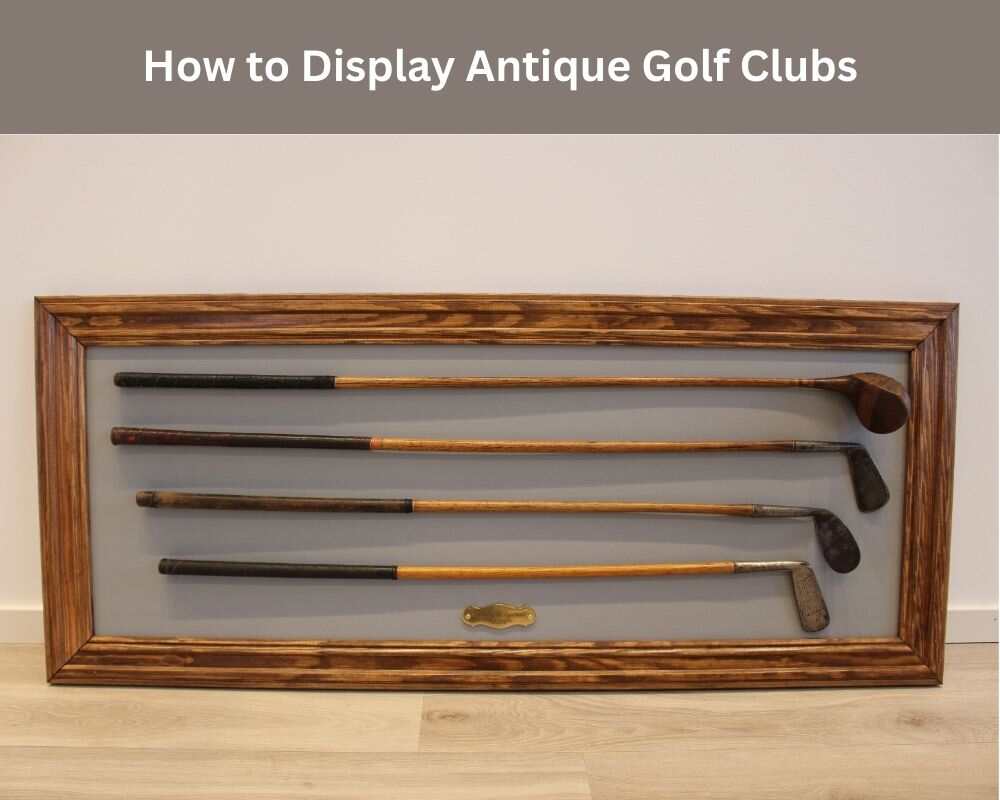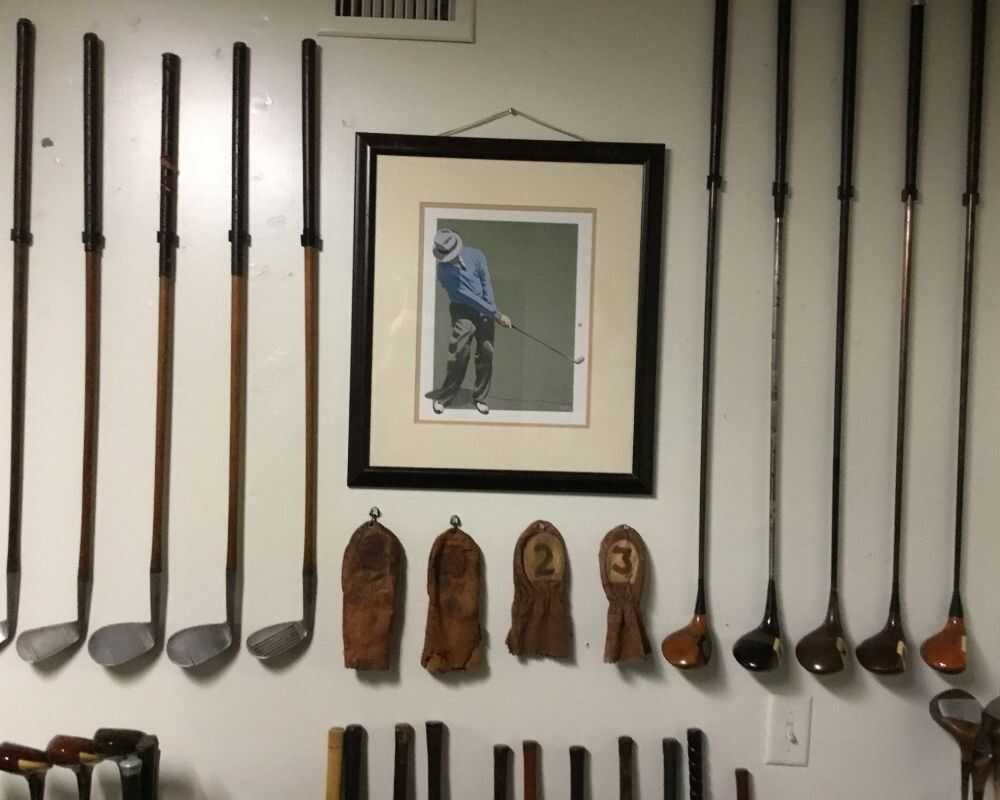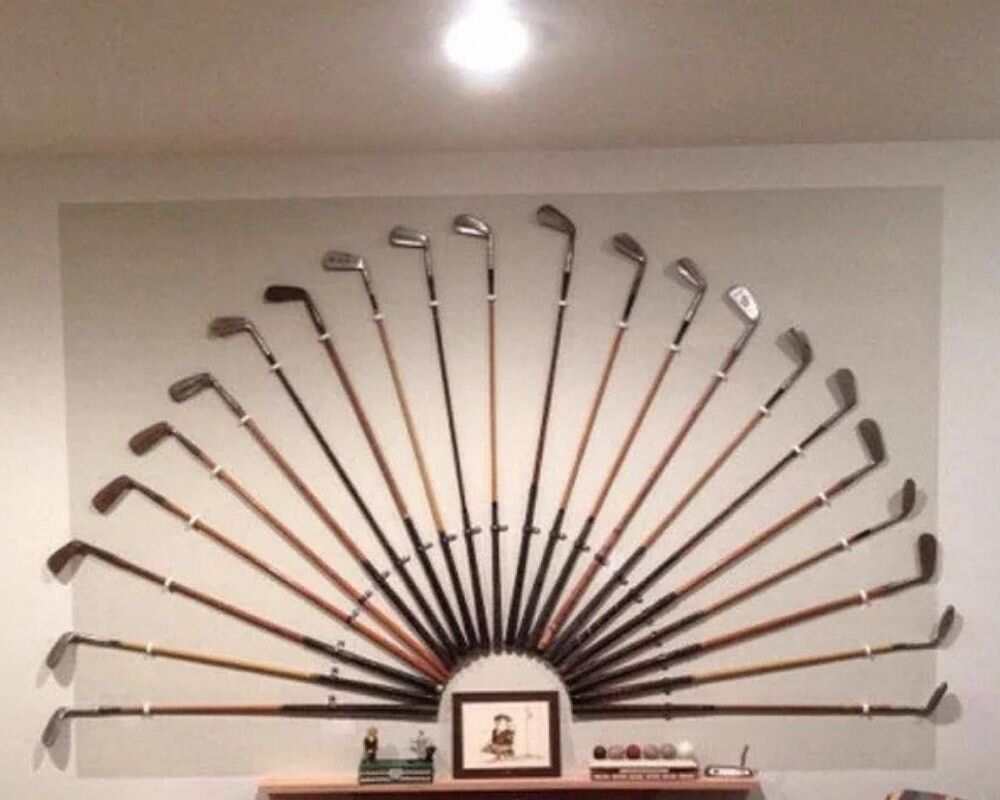The art of displaying antique golf clubs goes far beyond simply hanging old equipment on a wall. These cherished artifacts tell the story of golf’s evolution, from the hickory-shafted classics of the 19th century to the groundbreaking steel designs of the early 20th century.
So, how to display antique golf clubs in proper ways? Whether you’re a serious collector, golf enthusiast, or interior decorator, properly showcasing these historical pieces requires careful consideration of preservation, presentation, and historical context. Lets go through the displaying ways of antique golf clubs.
How to Display Antique Golf Clubs – Choose Perfect Display Method

Before diving into display methods, it’s crucial to understand what makes antique golf clubs worthy of display:
Historical Significance:
- Pre-1900 clubs featuring hand-forged iron heads
- Rare manufacturer marks and craftsman signatures
- Clubs used in significant tournaments or by notable players
- Experimental designs that influenced modern club development
Condition Factors That Impact Display:
| Condition Element | Description | Display Consideration |
|---|---|---|
| Original Finish | Preserved wood grain and metal patina | Affects lighting choices |
| Grip Integrity | State of leather/rubber wrapping | Determines mounting pressure |
| Shaft Stability | Structural soundness of wood/steel | Influences display angle |
| Head Authenticity | Original vs. restored components | Impacts historical value |
Essential Preservation Steps Before Display
Before mounting your antique golf clubs, proper preparation ensures their longevity:
- Professional Assessment
- Have an expert evaluate the clubs’ condition
- Document any existing damage or weak points
- Determine if restoration is needed or would diminish value
- Initial Cleaning
- Use appropriate materials for each component
- Document cleaning methods for future reference
- Avoid harsh chemicals that could damage original finishes
This foundational knowledge sets the stage for creating displays that not only showcase your clubs beautifully but also preserve them for future generations.
The way you showcase your antique golf clubs can dramatically impact their preservation and visual appeal. Let’s explore the most effective display techniques for different settings and collection sizes.
Wall-Mounted Displays of Antique Golf Clubs

Traditional Horizontal Mounting
| Mounting Style | Best For | Special Considerations |
|---|---|---|
| Club Racks | Full sets | Weight distribution across multiple points |
| Individual Mounts | Showcase pieces | Custom angles for optimal viewing |
| Shadow Boxes | Protected display | Climate control options |
| Cross-Pattern | Decorative impact | Balance and symmetry |
Recommended Materials for Wall Mounting:
- Acid-free backing materials to prevent corrosion
- UV-resistant acrylic cases for valuable specimens
- Custom-molded supports that match club contours
- Non-reactive metal brackets with protective coating
Environmental Control
Creating the ideal environment for your antique golf clubs is crucial for their longevity:
- Temperature Management
- Maintain consistent temperature between 65-70°F (18-21°C)
- Avoid placement near heating/cooling vents
- Install temperature monitoring systems for valuable collections
- Humidity Control
- Keep relative humidity between 45-55%
- Use dehumidifiers in basement displays
- Install humidity indicators in display cases
Lighting Considerations
Optimal Lighting Setup:
| Light Type | Benefits | Placement Tips |
|---|---|---|
| LED Spots | Low heat, adjustable | 12-18 inches from clubs |
| Ambient Natural | Even illumination | Use UV filters on windows |
| Display Case LEDs | Controlled environment | Install with dimming options |
| Track Lighting | Flexible positioning | Angle to minimize glare |
Key Lighting Principles:
- Avoid direct sunlight exposure
- Use LED lights with low UV emission
- Implement dimmer switches for adjustable intensity
- Position lights to highlight unique features
Thematic Displays of Antique Golf Clubs

The art of arranging antique golf clubs goes beyond basic organization—it’s about telling a story through thoughtful presentation and thematic grouping.
Chronological Arrangements
Timeline Display Concepts:
| Era | Characteristics | Display Focus |
|---|---|---|
| Pre-1850 | Featherie-era clubs | Emphasize handcrafted elements |
| 1850-1900 | Gutta-percha period | Showcase evolution of club heads |
| 1900-1930 | Early steel shafts | Highlight technological transition |
| 1930-1945 | Classic designs | Display manufacturing innovations |
Thematic Grouping Strategies
- Manufacturer-Based Collections
- Group clubs by historic makers
- Display maker’s marks prominently
- Include period advertisements or catalogs
- Showcase brand evolution
- Club Type Organizations
- Putters through drivers
- Evolution of specific club types
- Special-purpose club collections
- Experimental design groupings
Interactive Elements
Educational Display Components:
| Element | Purpose | Implementation |
|---|---|---|
| QR Codes | Digital information access | Link to club history |
| Descriptive Plaques | Context provision | Custom engraved details |
| Period Accessories | Historical context | Golf balls, tees, bags |
| Before/After Photos | Restoration documentation | Conservation story |
Professional Presentation Tips
Display Enhancement Techniques:
- Use period-appropriate backing materials
- Incorporate vintage golf photographs
- Add historical tournament memorabilia
- Include original purchase documentation
Layout Considerations:
- Maintain consistent spacing between clubs
- Create focal points with rare pieces
- Use symmetrical arrangements for balance
- Implement layered displays for depth
Protecting and Maintaining Your Antique Golf Club Display
Security and maintenance are crucial aspects of preserving your valuable collection while keeping it accessible for viewing and appreciation.
Security Measures
Essential Security Components:
| Security Element | Purpose | Implementation Tips |
|---|---|---|
| Display Cases | Physical protection | Museum-grade acrylic, keyed locks |
| Alarm Systems | Theft prevention | Motion sensors, contact alarms |
| Insurance Documentation | Value protection | Regular appraisals, detailed photos |
| Access Control | Controlled handling | Limited key distribution, log books |
Regular Maintenance Schedule
Monthly Maintenance Tasks:
- Inspection Routine
- Check mounting hardware security
- Inspect for pest activity
- Monitor humidity levels
- Assess light exposure effects
- Cleaning Protocol
- Dust with appropriate materials
- Clean display case surfaces
- Check for oxidation signs
- Document any condition changes
Professional Handling Guidelines
Safe Handling Practices:
| Activity | Required Equipment | Best Practices |
|---|---|---|
| Rotation | Cotton gloves | Support head and grip |
| Cleaning | Micro-fiber cloths | Gentle, directed motions |
| Transport | Padded carriers | Two-person handling |
| Remounting | Support cradles | Proper tool usage |
Documentation and Records
Essential Record Keeping:
- Detailed collection inventory
- Condition reports with photos
- Maintenance log entries
- Insurance documentation updates
- Authentication certificates
Digital Archive Components:
- High-resolution photographs
- Restoration history records
- Previous display arrangements
- Purchase documentation
- Expert appraisals
Troubleshooting Common Display Issues
Understanding the long-term implications of display choices and preparing for potential challenges ensures your antique golf club collection remains pristine for generations to come.
Problem-Solving Guide:
| Issue | Potential Causes | Solutions |
|---|---|---|
| Fading Grips | UV exposure | Install protective filters, rotate displays |
| Metal Oxidation | High humidity | Improve ventilation, add desiccants |
| Loose Mounts | Vibration/settling | Regular hardware checks, reinforcement |
| Wood Warping | Temperature fluctuations | Climate control upgrades, stabilization |
Special Event Displays
Temporary Exhibition Guidelines:
- Transportation Preparation
- Custom padding for each club
- Climate-controlled carrying cases
- Documentation for insurance
- Professional handling services
- Event Setup Considerations
- Temporary mounting solutions
- Enhanced security measures
- Proper lighting arrangements
- Information card placement
Future-Proofing Your Collection
Long-Term Preservation Strategies:
| Strategy | Implementation | Benefits |
|---|---|---|
| Digital Documentation | 3D scanning, photography | Historical record preservation |
| Succession Planning | Written instructions, heir education | Collection continuity |
| Conservation Fund | Dedicated maintenance budget | Ongoing care assurance |
| Professional Network | Restorer contacts, expert resources | Access to expertise |
Building Community and Sharing Knowledge
Collection Sharing Opportunities:
- Golf history society memberships
- Museum loan programs
- Educational demonstrations
- Collector community events
- Online documentation sharing
Conclusion
The goal of displaying antique golf clubs extends beyond personal enjoyment—it’s about preserving golf’s rich history for future generations. Your careful attention to display, maintenance, and preservation helps ensure these valuable artifacts continue to tell their stories for years to come.
This concludes the comprehensive guide to displaying antique golf clubs. The complete article provides detailed information across all crucial aspects of collection display and preservation.
